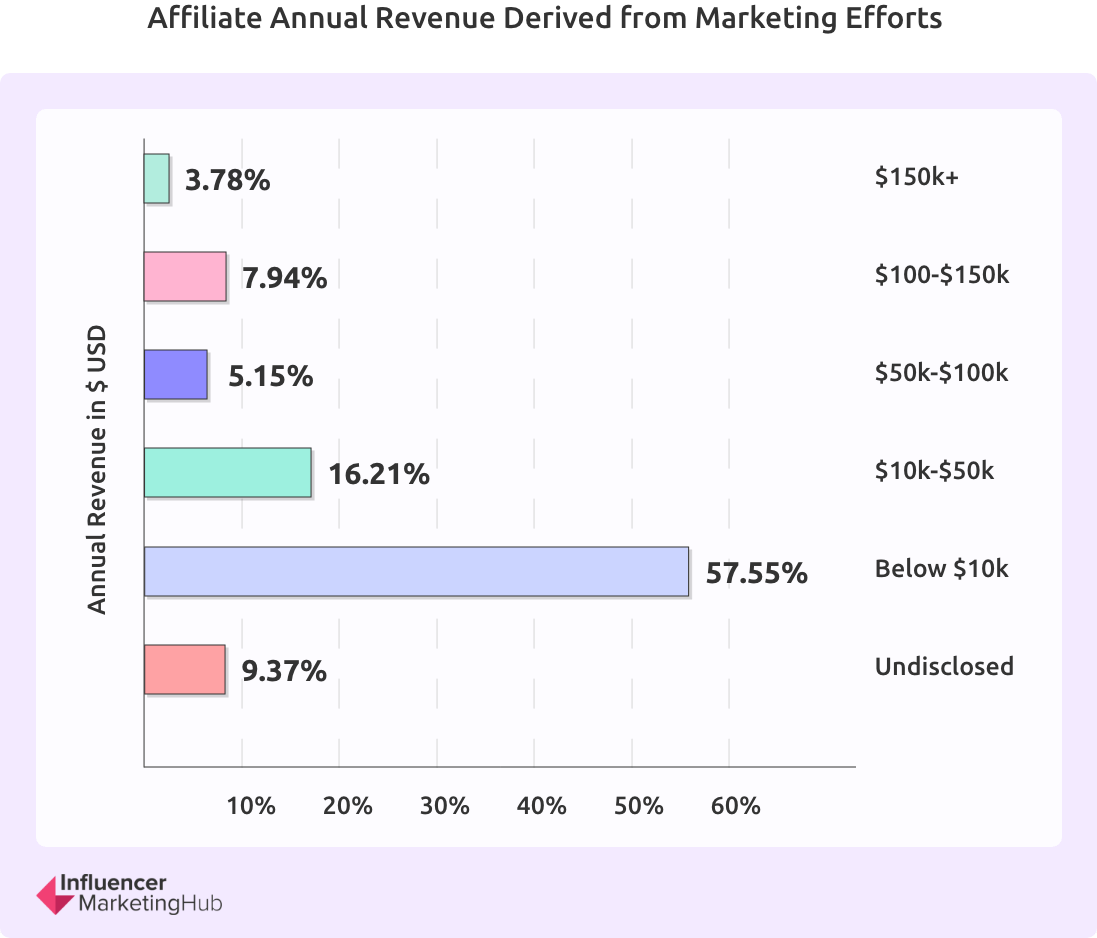Affiliate marketing connects businesses with partners that can drive traffic, generate more leads, and ultimately increase revenue for the brand.
It is a win-win for both sides. Affiliates get a commission for every sale they make and brands pay only when they see results. There are a lot of affiliate programs out there that drive results for brands as shown in the affiliate marketing statistics we will share today.
Even though affiliate marketing has been around since the early days of the internet, it’s only seen a sudden splurge in interest recently.
With more businesses relying on online channels to create sales and generate revenue, affiliate marketing statistics and trends show that it is here to stay.
In this article, we will look at the latest affiliate marketing statistics, facts, and trends.
What is Affiliate Marketing?
Affiliate marketing is a form of performance marketing where affiliates earn commissions based on website visits, signups, or sales they generate for a merchant.
The modern affiliate marketing industry was born in 1989 when Amazon first launched its Associates platform. According to Demandsage, affiliate marketing spending will be $15.7 billion in 2024. Also, about 83% of marketers are using affiliate marketing to grow their brand’s awareness.
Many brands are integrating this lucrative tactic into their marketing strategy. This is because affiliate marketing brings in high-quality leads and prospects, offers a wide range of benefits for both marketers and advertisers alike, and positively impacts customer loyalty and performance transparency.
Many traditional publishers are now even pivoting to affiliate marketing to earn revenue from their content.
Here are some affiliate marketing facts you need to know:
There are tons of digital marketing tips, tricks, and strategies available online. This makes it difficult to know where to start. So here’s a list of 8 ways you can improve your marketing efforts, based on my experience of working on both large and small digital marketing projects.
Affiliate marketing can drive up to 30% of your sales.
Amazon Associates is the largest affiliate network in the US for physical products. That’s because Amazon holds 50% of the eCommerce marketing in the US.
The average marketer spends 8% of their budget on paid advertising and 15% on content marketing.
About 16% of all online orders in the United States come from affiliate marketing, while 15% to 30% of all sales made by advertisers come from affiliate programs.
According to Google Trends, the interest in affiliates has increased by 300% and reached its peak popularity in July 2020.
An affiliate marketer can earn as much as $1,000 from a single sale.
According to Mediakix, Over 81% of businesses have affiliate programs
According to the influencer marketing hub, by 2022, the affiliate marketing industry will reach an estimated worth of $12 billion.
The global affiliate marketing spend is estimated to reach 15.7 billion in 2024.
Affiliate marketing has a market value of over $27.8 billion.
According to Google Trends Since 2015, the searches for the keyword “affiliate marketing” have increased by over 300%
The Size of the Affiliate Marketing Industry
The first step to building a successful digital marketing strategy is to understand the global affiliate marketing industry and know who your customers are. Once you have a good idea of their age, interests, and habits, it will be easier for you to understand which online channels they frequent and how to best reach them.
In fact, if you already have an eCommerce website, you can access existing customer data in order to make this process even easier.
Table: Country vs Affiliate Marketing Industry Value
Country | Affiliate Marketing Industry Value (USD)
---------------- | ---------------------------------------
United States | $6.8 billion
Japan | $3.3 billion
Germany | $1.3 billion
France | $522 million
Canada | $118 million
India | $96 million
Brazil | $33 million
Australia | $9.3 million
United Kingdom | $6.3 million1. About 73% of merchants agree they met revenue expectations by using affiliate marketing. (Satyanarayana, 2019)
Affiliate marketing contributes significantly to eCommerce sales, with research showing that many brands are happy with the results they are getting from their affiliate programs. About 73% of marketers are happy with the revenue generated from their affiliate marketing efforts.
2. About 20% of publishers’ annual income comes from affiliate marketing.
Affiliate marketing is great for content creators. On top of selling ad space, affiliate marketing programs make it easy to generate affiliate marketing revenue. According to 99firms, content affiliate marketing accounts for 20% of affiliate marketer’s annual income.
3. On average an affiliate marketer can earn about $51, 000 per year from affiliate marketing.
The average affiliate marketer can make $51, 000 a year from affiliate marketing alone. Understand that you have to put in the work to archive these numbers. When you put in the effort in affiliate marketing you can get the rewards for your hard work.

4. 90% of advertisers agree that affiliate marketing plays a crucial role in digital marketing strategy. (Hallur, 2021)
Given how the world is quickly shifting from traditional means of advertising, it’s no surprise that 90% of advertisers agree with this. Affiliate marketing campaigns do play a crucial role in today’s digital marketing strategies. It is one of the best ways to scale your business.
5. According to ZDNet, 76% of publishers say the best benefit of affiliate marketing is it is easy to monetize.
A study by zdnet.com has revealed that 76% of publishers say affiliate marketing’s best benefit is that it’s easy to monetize. This is largely because there are affiliate networks that make approval for affiliate programs fast.
US Affiliate Marketing Statistics
The total affiliate marketing industry is a giant, ever-growing sector with many brands adopting this strategy every year.
According to a recent report, there are over 11,400 affiliate programs across the United States. And, that’s just the tip of the iceberg.
Amazon Associates is still the leading affiliate program with around 1M active affiliates. The second-leading program is eBay Partner Network with over 500K active affiliates.
According to Statista, the affiliate industry has been growing at an average rate of 10% between 2014 and 2018.
6. Affiliate marketing spending will reach $8.2 billion by 2022.
The United States is one of the most lucrative markets for affiliate marketing trends. The US affiliate marketing industry is expected to hit $8.2 billion by 2022, which represents a compound annual growth rate (CAGR) of 10% over five years.
7. Affiliate marketing grew from $4.8 billion in 2016 to 6.8 billion in 2020
U.S. affiliate marketing spending grew from $4.8 billion in 2016 to $6.8 billion by 2020, according to Statista. This means there is a growing increase in demand for affiliate channels for companies to promote their products. And it lived up to the expectation of reaching that number that year.
8. In 2019, the U.S. accounted for approximately 42% of the global affiliate marketing spending (Source: Statista).
According to statistica, in 2019, the United States accounted for the most revenue generated with 42% of spending coming from them.
Impact Radius found that the insurance industry was the top affiliate sector in 2018, with a 34% share of revenues. However, this was down from 40% in 2017. Meanwhile, retail brands have risen from 22% to 25%.
10. The US had an estimated value of $6.82 billion in 2019 and is expected to reach $8.2 billion by 2022.
Overall, the US is the largest global affiliate market. It had an estimated value of $6.82 billion in 2019 and is expected to reach $8.2 billion by 2022.
U.K. Affiliate Marketing Statistics
Since its introduction to the UK in 1996, affiliate marketing has continued to grow and evolve. Today, it’s an important part of any small business’ marketing plan. It can help improve brand awareness, and website traffic, and increase sales.
In the U.K. affiliate marketing has become increasingly popular over the past decade. This has led to increased competition among affiliate marketers and businesses. More businesses are looking for affiliates.
Today, there are millions of websites around the world built around niche topics (like Global Tech Stack) that focus solely on reviewing products and services. Identifying profitable affiliate marketing niches, such as those in fashion, wellness, education, and travel, can be particularly lucrative due to the variety of sub-niches and their respective earning potentials. They are providing readers with transparent, accurate information about them.
That transparency has led many brands across industries to turn to affiliate marketers as part of their overall marketing strategy. They build long-term relationships with them to drive consistent traffic to their websites.
11. In 2020, the U.K. affiliate marketing industry reached a value of $510 million.
According to a study by ZDNet in 2019, the affiliate marketing world generated $510 million. This was a resulting increase of 8.4% from the figure recorded in 2018. This also goes to show how much the affiliate marketing industry is growing.
12. 16 % of online marketing spend goes towards affiliate marketing in the United Kingdom
Brand marketers in the U.K. play a crucial role in the affiliate marketing landscape, which accounts for 16% of all online marketing spend. This makes it the most popular form of online advertising by a large margin (11 percentage points more popular than PPC).
13. The number of brands using affiliate marketing in the U.K. has fallen from 92% to 81% in 2021,
This is partly due to COVID-19 causing many businesses to downsize or go out of business completely. Also due to how volatile the industry is becoming larger brands clamp down on their affiliate partners and focus on working with high-quality publishers that they can track and benchmark easily.
14. Affiliate Marketing Market Size & Revenue Statistics
There has been a 75% growth of affiliate marketing industry size since 2016 seeing 2023 having the industry worth a worping $27.8 billion. By 2027 it is estimated to reach $48.0 billion.
Table: Year vs Global Market Size
Year | Global Market Size (USD Billion)
-------------- | --------------------------------
2016 | $13 billion
2017 | $14.1 billion
2018 | $15.3 billion
2019 | $16.6 billion
2020 | $17.2 billion
2021 | $20.3 billion
2022 | $23.6 billion
2023 | $27.8 billion
2024* | $32.3 billion
2025* | $37.3 billion
2026* | $42.6 billion
2027* | $48.0 billionSource: Influencer Marketing Hub, Yahoo Finance.
Latest Affiliate Marketing Statistics for 2024
The affiliate marketing industry continues to evolve and grow, with new trends and statistics emerging each year. Here are some of the most recent statistics for 2024 that highlight the current state of the industry:
Global Affiliate Marketing Industry Growth: In 2024, the global affiliate marketing industry is projected to reach a market value of approximately $32.3 billion, reflecting a significant increase from previous years.
Affiliate Marketing Revenue Contribution: Affiliate marketing contributes to about 17% of total eCommerce sales globally, showcasing its vital role in driving online transactions.
Top Affiliate Marketing Niches: The most profitable affiliate marketing niches in 2024 continue to be the fashion, wellness, and technology sectors, with fashion alone accounting for nearly 25% of affiliate revenue.
Affiliate Marketing Spending: Global affiliate marketing spending is expected to surpass $15.7 billion in 2024, as more brands allocate larger portions of their marketing budgets to affiliate campaigns.
Affiliate Marketer Earnings: High-earning affiliate marketers are seeing a rise in income, with some earning upwards of $100,000 annually due to successful partnerships and strategic affiliate marketing efforts.
Affiliate Traffic Sources: SEO remains the leading source of affiliate traffic, with over 70% of affiliate marketers reporting it as their primary method for driving visitors to their affiliate sites.
Mobile Affiliate Marketing: Mobile devices account for nearly 60% of affiliate traffic in 2024, underscoring the importance of mobile optimization for affiliate websites and campaigns.
Affiliate Marketing Fraud: Despite its growth, the affiliate marketing industry faces challenges with fraud, costing businesses an estimated $1.4 billion annually. This highlights the need for robust fraud prevention measures.
Affiliate Networks Expansion: The affiliate networks industry is expanding, with new platforms emerging to cater to niche markets and specialized affiliate programs.
Affiliate Marketing Trends: Influencer collaborations and video content are among the top affiliate marketing trends in 2024, as they offer engaging ways to connect with audiences and boost brand awareness.
These statistics illustrate the dynamic nature of the affiliate marketing world and its continued importance in the digital marketing landscape.
Affiliate Marketing Industry Projection Up to 2030
The affiliate marketing industry is poised for continued growth and evolution as we look towards 2030. With advancements in technology and shifts in consumer behavior, the landscape is expected to change significantly.
Here’s a glimpse into the projected trends and growth for the affiliate marketing industry through the next decade:
Continued Market Expansion: The global affiliate marketing market is anticipated to grow at a steady pace, potentially reaching a market size of over $60 billion by 2030. This expansion is driven by increased digitalization, the rise of eCommerce, and the growing adoption of affiliate marketing strategies by businesses worldwide.
Technological Innovations: Emerging technologies such as artificial intelligence, machine learning, and blockchain are expected to revolutionize affiliate marketing. These technologies will enhance targeting, tracking, and transparency, making affiliate campaigns more efficient and reliable.
Diverse Affiliate Niches: As consumer interests diversify, new affiliate niches are likely to emerge. Sectors such as sustainable products, digital health, and virtual reality experiences are expected to gain prominence, offering fresh opportunities for affiliate marketers.
Enhanced Mobile Integration: With mobile devices continuing to dominate internet usage, mobile-friendly affiliate marketing strategies will become crucial. This includes optimizing websites for mobile, leveraging mobile apps, and utilizing SMS marketing to reach audiences effectively.
Increased Focus on Compliance and Fraud Prevention: As the industry grows, so does the potential for fraud. Enhanced compliance measures and advanced fraud detection technologies will be essential to safeguard affiliate marketing investments and ensure ethical practices.
Influencer and Content Marketing Synergy: The integration of influencer marketing with affiliate strategies will become more pronounced. Brands will collaborate with influencers to create authentic content that drives affiliate sales, leveraging the trust and engagement influencers have with their audiences.
Sustainability and Ethical Marketing: As consumers become more conscious of environmental and ethical issues, affiliate marketing campaigns will need to align with these values. Marketers will focus on promoting sustainable and ethically produced products to meet consumer demand.
These projections indicate a promising future for the affiliate marketing industry, with ample opportunities for growth and innovation. As businesses and marketers adapt to these changes, the industry is set to remain a vital component of the digital marketing ecosystem.
In Summary: Affiliate Marketing stats
While there are not many statistics about affiliate marketing, in particular, there is a wealth of information about the e-commerce industry as a whole.
Since affiliate marketing is an important part of generating revenue for brands, knowing these stats can give you an idea of how useful this channel may be for your business. Additionally, affiliate marketing fraud is a growing concern, costing businesses billions annually and highlighting the need for vigilance against potential scams.
Affiliate marketing is one of the most cost-effective ways to promote your products and drive sales.
For businesses, you only pay commissions when there is a sale or lead generated. This means that you don’t need to spend money on advertising if no one buys what you are selling!
Check out these blog posts to learn more





